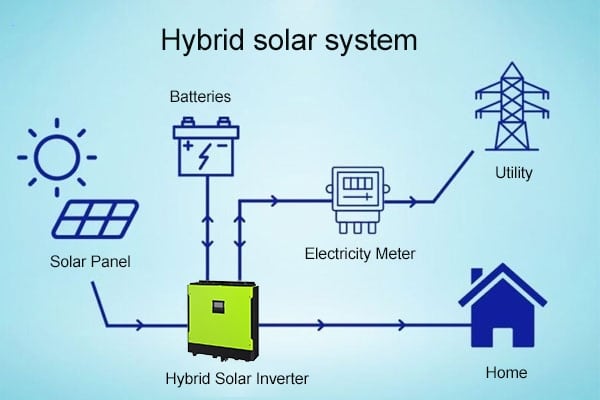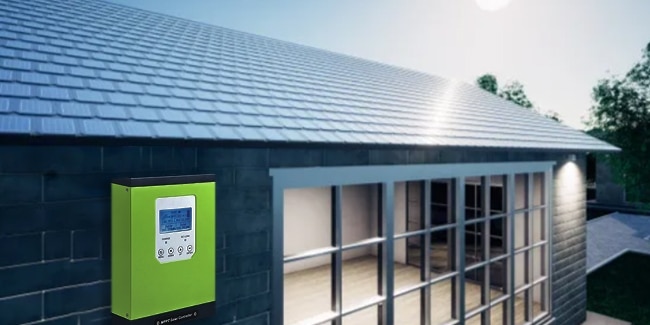Has the very consternation ever taken you about how every household can use sunshine energy?
That’s true, electricity bills are too high. You have probably heard of solar inverters and may already have one. What is meant by storage of energy or making use of it in any way at all is certainly something to be learned with hybrid solar inverters leading the charge at top speed just around the corner.
Let’s find out why such a great many people are turning to hybrid inverters daily.
What is a Hybrid Solar Inverter?
But before speaking of what a good idea it is, what about this concept: inverters actually do?
That’s a Hybrid Solar Inverter in a nutshell. It’s the keystone of the solar system. It unites into one system your solar panels, energy storage, and grid power. It controls how energy is employed, whether it goes first to your home, gets stored in the battery for a rainy day, or is sent back on the grid to others.
In short, a regular solar inverter and a battery inverter are combined physically into one unit, and so combine their functions.
Why Do More People Choose Hybrid Inverters
For Solar Systems Together, the catch makes all the difference. An inverter offers more than just smarter usage of electrical energy; it also provides backup during power interruptions and normal, steady operation day to day. Let’s break it down into simple points.
1. One Device, Many Jobs
A hybrid inverter handles multiple tasks at once. So, instead of buying different equipment for battery charging, solar panel connection, and grid supply, this one unit does it all. That means:
- Less wiring, fewer devices
- Easy to install
- Saves space and reduces mess
2. Battery Storage is Already Part of the Plan
The best thing about a hybrid system is how it manages solar battery storage. It allows extra solar energy to be stored during the day so you can use it at night or when the power goes out.
This means:
- No wasted solar power
- Lower electricity bills
- Peace of mind during outages
3. Smart Energy Management
Most hybrid inverters have these functions: with advanced features, they let you track energy use on a minute-by-minute or even second-by-second basis. Over screens and peripherals corresponding to your hardware products, your PV system can track how much of its output is being used by itself in real time.
Therefore, we not only discover if the force is just right, but also how to use electricity efficiently. If you know that less potential energy left in the solar panels during the day means more consumption will be required at home after dark, for example, then it helps make smarter decisions about electric power.
However, if your hybrid inverter lacks these features, there are some common smart functions. They include:
- Load shifting: running appliances at off-peak times
- Auto switch among solar, battery, and grid
- Monitoring apps or web portals
4. Reliable During Power Cuts
In countries where power cuts happen often, this is very important. Hybrid inverters provide backup power as needed. In the event of a grid failure, they can switch instantly to battery mode so that your fans, lights, and essential devices continue to run.

5. Works With or Without the Grid
Even though you may not have a conventional power grid, a hybrid inverter is made to work. It’s equally at home in remote areas that don’t have available electricity supplies or farmhouses located off the beaten path and vulnerable to brief blackouts.
In addition, if you are connected to a grid, you can still take advantage of the time:
- Sending excess power back and earning credits
- Pulling power only when batteries and solar are not enough
6. Easy Upgrade Option
If you already have a solar system without a battery, adding a hybrid inverter means you’re future-ready. Even if you don’t want to add batteries now, you can easily do that later. It gives you flexibility.
7. Quiet and Neat Setup
Compared to using separate inverters for solar and batteries, a hybrid one runs quieter and has a cleaner installation look. No extra noise, no mess of extra boxes.
How It Works – Simple Explanation
Let’s say it’s a sunny afternoon and your solar panels are generating more energy than your home needs. Here’s what a hybrid inverter would do:
- First, it powers your home devices
- Then, it sends the extra power to charge your battery
- If there’s still more left, it can push it back to the grid (if allowed in your area)
Now, during the night or when there’s no sun:
- The inverter automatically pulls power from the battery to run your home
- If the battery runs low, it uses grid power as a last option
Where Hybrid Solar Inverters Fit Best
Hybrid inverters can be used in many types of places:
- Homes with frequent power cuts
- Offices needing uninterrupted power for systems
- Shops and clinics where fridges, lights, and devices need to keep running
- Remote locations with no stable electricity
- Farmhouses and weekend homes where solar is the main source
How to Choose the Right Hybrid Solar Inverter
Choosing the right hybrid solar inverter is essential not only for having reliable backup power, smooth operation from your panels, but it can also lead to longer-term performance and sustainability.
P purchasing, you need to consider what your primary usage will be after purchase.
1. Determine Your Power Requirements
Count up the wattage of all electrical devices you plan to power. This is the basis for selecting the right-size models (e.g., 1kW, 3kW, 5kW).
2. Check Battery Compatibility
A good all-in-one solar inverter supports various kinds of batteries, including lead-acid, lithium-ion and GEL. That way you, as a residential power customer, can perform a simple upgrade when needs change in the future (for example if costs are lowered by market demands).
3. Look for Smart Energy Management
Choose a model where it can automatically shift between solar, battery or grid power depending on changes in the level of solar radiation or present residential energy demand. This will ensure that you can enjoy uninterrupted service during outages and will also help you maximize your utility savings.
4. Make Sure It Has MPPT Technology
A product incorporating MPPT technology will get better power from the panels in winter conditions, ensure that solar efficiency is higher and have higher maximum power output from a panel array.

5. Consider Backup Time and Load Support
Check how long the inverter can support essential household appliances such as lights, fans, refrigerators or pumps when power to them is cut off.
6. Look for Remote Monitoring
Some of the more modern inverter models allow you to view solar production and battery condition from a simple smartphone app. Obviously, this is very useful to the typical man in the street, and for modern-day sys operations or temporary field management.
7. Check Build Quality and Protections
Select an inverter that has built-in protections such as over-current protection, short-circuit protection, and high/low voltage protection. This will ensure the inverter has a longer life.
8. Choose a Reputable Brand With After-Sales Support
A good brand is not only stable, but also has a better warranty and is easier to maintain.
How Hybrid Inverters Compare to Other Inverter Types
Hybrid solar inverter (Depending on the type you buy, from battery-bank.): If you connect 220V directly to the inverter’s battery, this can provide one form of backup to your grid-connected household off-grid inverter thus the old household inverter would automatically power down and start drawing power from batteries instead.
- Emergency Power Supply: When the grid is interrupted, a traditional grid-tied inverter will shut down. A hybrid inverter can continue to supply power by switching over to battery mode.
- Energy Management: A grid-tied inverter can only pass power on to the grid and also take solar in real-time. The hybrid power station operates a compression vehicle that, with air-pressure just below one bar (15 psi) or even zero itself, ejects liquid nitrogen for use in the air collection process.
- The ability to produce electricity and then transmit this power over time is reduced because its source is now one left by itself, but in principle, all one needs for an environmental wall being maintained indefinitely, there should always be a market in which this energy can be sold.
- Future Expansibility: It is difficult to add batteries to grid-tied systems. A hybrid inverter system is designed this way, and so the investment can be better put to long-term use.
Hybrid Inverter vs. Off-Grid Inverter
- Grid Connectivity: Off-grid inverters are stand-alone and cannot export electricity to the grid. Hybrid inverters can work whether there is power from your utility company or not, and their flexibility is high.
- Energy Usage Options: Off-grid inverters only have the ability to rely on battery storage systems, while hybrid inverters have the entire system that includes solar, battery, and grid. It will automatically choose an optimum method of powering for any given hour or time without any human intervention needed at all.
- Many hybrid inverters now have intelligent energy management features. They can give solar priority, control charging of batteries or other storage units for power, and it is also possible to decide to use at different times in the day in order not only to save electricity costs but also to avoid peak demand if necessary.
- Scalability: It’s much easier to expand system capacity into the future with hybrid inverters. But offline units are more limited, and once you’ve maxed them out, there’s no way back.
To Sum Up
Hybrid Solar inverters are a smart choice If you’re thinking about making a home or workplace your own private power plant. Sunlight can be efficient and cost-cutting, while a backup off-grid system ensures that no matter when the plug is pulled, it’s convenient to operate. Practical for public demand courses, now they’re on the threshold of solar output.

